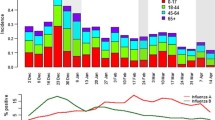Abstract
Weekly incidence data for influenza-like illness, routinely collected in sentinel general practices in England and Wales and in the Netherlands over 10 winter periods (week 37 in one year to week 20 in the next, 1987/1988–1996/1997) were examined in conjunction with matching virus isolate data to define epidemic periods of influenza in the two countries. We first defined the background rates of recording influenza-like illness which occurred at times when only sporadic or no isolations of virus were reported. The background rates were similar in the two networks with mean weekly incidence in England and Wales of 28.1 per 100,000 (all ages) and in the Netherlands 29.8. Epidemic periods defined as lying above the upper 95% confidence level of the background rate lasted on an average of about 10 weeks. Once epidemics were recognised, peak incidence was generally achieved within 4 weeks. The excess population (all ages) consulting general practitioners during influenza epidemic periods was calculated from the difference between the observed and background incidence rates, and expressed as a percentage of the total population. In the 10 periods surveyed, the percentage of the population consulting and diagnosed with influenza-like illness in England and Wales ranged from 0.4% in 1991/1992 to 1.7% in 1989/1990 and in the Netherlands from 0.5% in 1990/1991 to 2.1% in 1989/1990. The duration and epidemic periods were broadly similar in the two countries though the excess consulting population during the 10 epidemics studied averaged 0.85% in England and Wales compared with 1.39% in the Netherlands. There were substantial differences between the two countries in the impact of influenza in individual years, as measured in the consulting population even though the predominant virus (sub)types were similar.
Similar content being viewed by others

References
Shortridge KF. The next pandemic influenza virus. Lancet 1995; 346: 1210–1212.
Ravelli ACJ, Kreis IA. A time series analysis of sulphur dioxide, temperature, and influenza incidence in 1976–1987. Pub Health Rev 1991–92; 19: 93–101.
Serfling RE. Methods for current statistical analysis of excess pneuomonia-influenza deaths. Public Health Reports 1963; 78(6).
Fleming DM, Cohen J-M. Experience of European collaboration in influenza surveillance in the winter of 1993–1994. J Publ Hlth Med 1996; 18: 133–142.
Dedman DJ, Watson JM. The use of thresholds to describe influenza activity. PHLS Microbiol Digest 1997; 14(4): 206–208.
Birmingham Research Unit of the Royal College of General Practitioners. Influenza. J Royal College of General Practitioners 1977; 27: 544–551.
Sprenger MJW, Naelten AMG van, Mulder PGH, Masurel N. Influenza mortality and excess deaths in the elderly, 1967–82. Epidemiol Infect 1989; 103: 633–641.
International Classification of Health Problems in Primary Care (ICHPPC-2 Defined). Prepared by the Classification Committee of World Organisation of National Colleges and Academic Associations of General Practitioners/Family Physicians (WONCA) in collaboration with the World Health Organisation (WHO). 3rd edn. Oxford Medical Publications, 1983.
Fleming DM, Chakraverty P, Sadler C, Litton P. Combined clinical and virological surveillance of influenza in winters of 1992 and 1993–94. Br Med J 1995; 311: 290–291.
Masurel N, Bartelds AJM, Baars AMJW, van Wijngaarden JK, Claas ECJ. Influenza in het seizoen 1992/93; vaccinsamenstelling voor heit seizoen 1993/94. Ned Tijdschr Geneeskd 1993; 137(39): 1987–1990.
Govaert Th.ME, Dinant GJ, Aretz K, Masurel N, Sprenger MJW, Knottnerus JA. Adverse reactions to influenza vaccine in elderly people: randomised double blind placebo controlled trial. Br Med J 1993; 307: 988–990.
Fleming DM, Cross KW. Respiratory syncytial virus or influenza? Lancet 1993; 342: 1507–1510.
Nicholson KG, Kent J, Hammersley V, Cancio E. Acute viral infections of upper respiratory tract in elderly people living in the community: Comparative, prospective, population based study of disease burden. Br Med J 1997; 315: 1060–1064.
Claas ECJ, Jong JC de, Bartelds AIM, Bijlsma K, Rothbarth P, Groot R de, Rimmelzwaan GF, Osterhaus ADME. Influenza types and patient population. Lancet 1995; 346: 180.
The Shorter Oxford Dictionary. Oxford University Press.
Fleming DM. The impact of three influenza epidemics on primary care in England and Wales. Pharmaco-Economics 1996; 9(Suppl 3): 38–45.
McCormick A, Fleming D, Charlton J. Morbidity Statistics from General Practice: Fourth national study 1991–92. London: HMSO, 1995 (Series MB5 no3).
Velden J van der, Bakker DH de, Claessens AAMC, Schellevis FG. Morbidity in General Practice: Dutch National Survey of General Practice. Netherlands Institute of Primary Health Care (NIVEL) 1992, PO Box 1568–3500 BN Utrecht.
Hayden FG, Osterhaus ADME, Treanor JJ, Fleming DM, Aoki FY, Nicholson KG, Bohnen AM, Hirst HM, Keene O, Wightman K. Efficacy and safety of the neuraminidase inhibitor Zanamavir in the treatment of influenza virus infections. N Engl J Med 1997; 337: 874–880.
Fleming DM, Ayres JG. Diagnosis and patterns of incidence of influenza, influenza-like illness and the common cold in general practice. J Royal College of General Practitioners 1988, 38; 159–162.
Jong JC de, Claas ECJ, Osterhaus ADME, Webster RG, Lim WL. A pandemic warning? Nature 1997; 389: 554.
van Casteren V. Leurquin P. Eurosentinel: Development of an international sentinel network of general practitioners. Meth Inform Med 1992; 31: 147–152.
Snacken R, Bensadon M, Strauss A. The CARE telematics network for the surveillance of influenza in Europe. Meth Inform Med 1995; 34: 518–522.
Zambon M. Sentinel surveillance of influenza in Europe 1997/98. Eurosurveillance 3: 29–31.
Author information
Authors and Affiliations
Rights and permissions
About this article
Cite this article
Fleming, D., Zambon, M., Bartelds, A. et al. The duration and magnitude of influenza epidemics: A study of surveillance data from sentinel general practices in England, Wales and the Netherlands. Eur J Epidemiol 15, 467–473 (1999). https://doi.org/10.1023/A:1007525402861
Issue Date:
DOI: https://doi.org/10.1023/A:1007525402861



